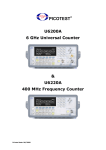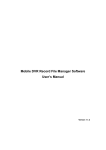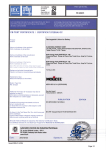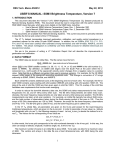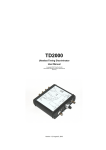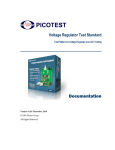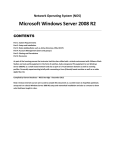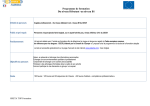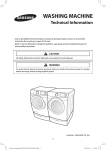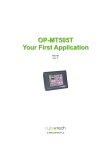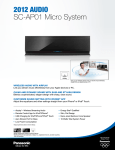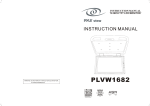Download to a PDF of the complete specifications.
Transcript
Product Information - Picotest U6200A Universal Counter The Picotest U6200A offers a higher frequency capability, better oscillator temperature stability, higher voltage measurement bandwidth, higher resolution and many other benefits compared with the competition. The U6200A CH3 is included free and has a range from 375 MHz to 6GHz. An optional 20GHz module is also available. The rear inputs are not connected to the front panel inputs, allowing up to 5 measurement channels. Other benefits compared with the competition include faster measurements, faster statistics, USB and LAN inputs, better damage protection levels and electronic calibration. Like all Picotest products, it’s backed by our 3 yr warranty and 30 day refund policy • • • • • • • • • • • • • 12 Digit Resolution Easy to use keypad 1mHz – 400MHz Ch1 and CH2 375MHz to 6GHz on CH 3 included FREE 10MHz synchronization included FREE Optional rear Inputs are isolated from the front panel allowing 4+1 measurement channels 40ps time domain function resolution. Time Base Stability: < 1 PPM temperature and <2PPM per year Optional Oven Stability <5PPB temperature and <80PPB per year Electronic Calibration Statistics & Math Functions 20GHz module option available SCPI commands are compatible with the Agilent 53132A Detailed Specifications - Picotest U6200A Universal Counter 12 Digits Resolution & 6 GHz Frequency Measurement The Picotest U6200A universal counter, whose production procedures conform to ISO 9004, has a frequency resolution of 12 digits per second, 40 ps time interval resolution and a complete set of test and analysis features. The standard U6200A’s CH3 has a range from 375 MHz to 6GHz and the standard CH 1 & 2 has a range from 1 mHz to 400 MHz. Great Features for Universal Purposes The Picotest U6200A also provides great features including Frequency & Ratio (11Digits/Sec.), Time interval, Period (2.5 ns to 1000s), Duty Cycle, Pulse Width, Rise/Fall Time, Peak Volts (100 Hz~300 MHz), Phase, Totalize, Temperature Stability (< 1 PPM), Aging Rate (< 2 PPM per year), timebase reference channel and complete Front-End Isolation. Moreover, it offers 20 memory locations for storing frequently-used operations. Full Math Functions & Easy Operation Panel The Picotest U6200A offers built-in statistics and math functions. Users can make measurements, simultaneously measure and report mean, min/max, delta and standard deviation. Scale & offset can be easily used for compensation purpose according to the users’ applications. In addition, in order to obtain these measurements, the user can easily use the numeric buttons to define settings. The U6200 also provides users with visual indications of selected functions. Fast Measurement & Special Application The U6200A supports real-time digital signal processing technology, which can be applied to analyze data while simultaneously obtaining new readings and speeding measurement. The “Limit Modes” feature is worth to be mentioning since users can set margin according to their specific measurements, and via Go-On or Stop and USB Output settings, the U6200A can continue or stop measuring as a limit is exceeded, and generate an output signal to trigger external devices. Free Software & Familiar SCPI Commands Users can obtain data logs via PC software (Microsoft Excel®) using a USB, or an optional GPIB interface. Furthermore, U6200A also supports a webserver function, so users can easily control it via a LAN interface (Figure 10) by entering an Ethernet address (Default: 192.168.0.247) on web browsers. In addition, through the SCPI commands compatible with Agilent 53132A, the Picotest U6200A can utilize familiar syntax string for users’ applications. For more command information, please refer to the U6200A User’s Manual in Chapter 7. Accessories 1. 2. 3. 4. High stability oven oscillator module : U6200-OPT01 250MHz-20GHz RF module : U6200-OPT02 Rear Input (CH1/2) module : U6200-OPT04 Rear panel input module -- CH1/2/3 : U6200-OPT05 Specification List Channel 1 & 2 Input Specifications DC Coupled 1mHz to 400 MHz 200KHz to 400 MHz (50 Ω) AC Coupled 30 Hz to 400 MHz (1 MΩ) FM Tolerance FM Tolerance: 25% Voltage Range and Sensitivity 20 mVrms to ±5 V ac + dc (Medium and High) 1mH to 225 MHz 25 mVrms to ±5 V ac + dc (Low) (75 mVrms with optional rear connectors) 30 mVrms to ±5 V ac + dc 225 MHz to 400 MHz (75 mVrms with optional rear connectors) Channel 1 & 2 Input Characteristics Impedance 1 MΩ or 50 Ω (ATT X 1, 1 MΩ 24 pF Capacitance) (ATT X 10, 1 MΩ 15 pF Capacitance) Coupling AC or DC 100 KHz (or disabled) Low-Pass Filter – 20 dB at > 1 MHz Selectable between Low, Medium(default), or High Input Sensitivity Medium is approximately 1.35x High Sensitivity, low is approximately 1.7x High Sensitivity Internal Noise 200uVrms(typical) Voltage Range and Sensitivity (Single-Shot Pulse) 1.5ns to 10ns Pulse 80 mVpp to 10 Vpp Width (150 mVpp with optional rear connectors) 50 mVpp to 10 Vpp >10 ns Pulse Width (150 mVpp with optional rear connectors) Trigger Level(ATT x 1) Range ±5.125 V Accuracy ±(15 mV + 1% of trigger level) Resolution 2.5mV ATT x 10 Range X 10 Trigger Slope Positive or Negative Range Auto Trigger Level 0 to 100% in 1% steps Peak Voltage fast mode >10 KHz Frequency Peak Voltage slow mode > 100 Hz Amplitude> 100 mVpp (No amplitude modulation) 1. Specifications and Characteristics for Channels 1 and 2 are identical for both Common and Separate Configurations. 2. Values shown are for x 1 attenuator setting. Multiply all values by 10 (nominal) when using the x 10 attenuator setting. Note that it may necessary to recalibrate the input offset in the application environment (especially at high temperature) to achieve maximum sensitivity. Damage Level DC~400MHz 50 Ω 12 Vrms 0 to 3.5 kHz, 1 MΩ 350 V dc + ac pk 3.5 kHz to 100KHz, 350 V dc + ac pk linearly derated to 12 Vrms 1 MΩ 100KHz to 400MHz, 12 Vrms 1 MΩ Attenuator Voltage Range x10 Trigger Range x10 Channel 3 Input Specifications Frequency Range 375 MHz to 6 GHz Channel 3 Input Characteristics Impedance 50 Ω Coupling AC VSWR < 2.5:1 Power Range and Sensitivity (Sinusoid) 375 MHz to 500 MHz -16 dBm to +15 dBm 500 MHz to 1 GHz -20 dBm to +15 dBm 1 GHz to 2 GHz -23 dBm to +15 dBm 2 GHz to 4 GHz -25 dBm to +15 dBm 4 GHz to 5 GHz -21dBm to +15 dBm 5 GHz to 5.5 GHz -20 dBm to +15 dBm 5.5 GHz to 6 GHz -17 dBm to +15 dBm Damage Level +25 dBm, DC ±12V Option Channel 3 Input Specifications (U6200-opt02) Frequency Range 250 MHz to 20 GHz Option Channel 3 Input Characteristics (U6200-opt02) Impedance 50 Ω Coupling AC VSWR < 2.5:1 Power Range and Sensitivity (Sinusoid, at 25ºC) 250-500MHz -22~+23dBm 0.5-14GHz -27~+23dBm 14-15GHz -21~+23dBm 15-16GHz -19~+23dBm 16-19GHz -17~+23dBm 19-20GHz -13~+23dBm Damage Level +26 dBm, DC ±24V External Arm Input Specifications Signal Input Range LVTTL and TTL compatible Timing Restrictions Pulse Width > 50 ns Transition Time < 250 ns Start-to-Stop Time > 50 ns Damage Level 12 Vrms External Arm Input Characteristics Impedance 1 kΩ Input Capacitance 17 pF Start Slope Positive or Negative Stop Slope Positive or Negative 1. External Arm is available for all measurements except Peak Volts. Notes 2. External Arm is referred to as External Gate for some measurements. Internal Time Base Stability Temperature Stability (referenced to 25°C) Standard High Stability Oven (0° to 50°C) (U6200-opt01 for U6200A only) ± 1 x 10E-6 ± 5 x 10E-9 Per Day Aging Rate ± 8 x 10E-10 Per Month Per Year ± 2 x 10E-6 ± 8 x 10E-8 Turn-on stability vs. time (30 ± 2.0 x 10E-8 min.) (referenced to 24 hours) Calibration Electronic Electronic External Time Base Input Specifications Voltage Range 200 mVrms to 10 Vrms Damage Level 12 Vrms External Time Base Input Characteristics Threshold 0V Impedance 1 kΩ Input Capacitance 25 pF Input Frequency 10 MHz Internal vs. External Time Manual Select Internal or External Base Selection Automatic Internal used when External not present (default) Time Base Output Specifications Output Frequency 10 MHz Voltage 570 mVpp (0 dBm), typical Impedance 50 Ω (typical), AC coupled Measurement Specifications Frequency, Period Channel 1 and 2 Trigger “Auto” Gate Time STD CH 3 1 mHz to 400 MHz (2.5 ns to 1000 s) Default setting is Auto Trigger at 50 % 0.1 sec 375 MHz to 6 GHz (0.166 ns to 2.6 ns) Frequency Ratio CH 1/ CH 2, CH 1/ CH 3, CH 2/ CH 1, CH 3/ CH1 (Measurement is specified over the full signal range of each input.) Results Range 10E-10 to 10E+11 “Auto” Gate Time 0.1 sec Time Interval Measurement is specified over the full signal ranges of Channels 1 and 2. The width of the Trigger Default setting is Auto Trigger at 50 % Results Range -0.5 ns to 10E+5 s pulse must be greater than 1 ns, frequency range to 300 MHz. Resolution 40 ps RMS Resolution 120 ps Systematic Uncertainty Pulse Width Time ±(TI × Time Base Error) ± Trigger Level Timing Error ± 500 ps Differential Channel Error Measurement is specified over the full signal range of Channel 1. The width of the pulse must be greater than 1 ns frequency range to 300 MHz). Pulse Selection Positive or Negative Trigger Default setting is Auto Trigger at 50% Results Range 1.5 ns to 10E+5 s Resolution 40 ps RMS Resolution 120 ps Systematic ± (Pulse Width Time x Time Base Error) ± Trigger Level Timing Error ± 500 ps Differential Uncertainty Channel Error. Rise/Fall Time Measurement is specified over the full signal range of Channel 1. The width of the pulse must be greater than 1 ns frequency range to 300 MHz). Edge Selection Positive or Negative Trigger Default setting is Auto Trigger at 10% and 90% Results Range 2 ns to 10E+5 s Resolution 40 ps RMS Resolution 120 ps Systematic ± (Edge Time x Time Base Error) ± Trigger Level Timing Error ± 500 ps Differential Uncertainty Channel Error Phase Measurement is specified over the full signal range of each input. The width of the pulse Results Range -180° to +360° must be greater than 1 ns, frequency range to 300 MHz Resolution 40 ps RMS Resolution 120 ps Systematic ± (Trigger Level Timing Error) ×Frequency Uncertainty Duty Cycle Measurement is specified over the full signal range of Channel 1. The width of the pulse must be greater than 1 ns, frequency range to 300 MHz Pulse Selection Positive or Negative Trigger Default setting is Auto Trigger at 50 % Results Range 0 to 1 Resolution 40 ps RMS Resolution 120 ps Systematic Uncertainty Totalize ± Trigger Level Timing Error ± 500 ps Differential Channel Error Measurement is specified over the full signal range of Channel 1. The width of the pulse must be greater than 1 ns, frequency range to 400 MHz Pulse Selection Positive or Negative Trigger Default setting is Trigger at 0 V Results Range 0 to 10E+15 Resolution 1 count Systematic ± 1 count Uncertainty Peak Voltage Results Range -5.1 V to + 5.1 V Resolution 2.5 mV DC Signals 15 mV + 2 % of V peak-to-peak amplitude greater than 200 mV DC Signals (ATT x 10) 150 mV + 2 % of V peak-to-peak amplitude greater than 1 V 100 Hz ~ 10 KHz 15 mV + 2 % of V 1 Vp-p, 50 Ω, ATT OFF 10 KHz ~ 5 MHz 15 mV + 4 % of V 5 MHz ~ 80 MHz 15 mV + 7 % of V peak-to-peak amplitude greater than 200 mV 80 MHz ~ 300 MHz 15 mV + 15 % of V The peak volts measurement will keep operating up to 400 MHz, although results act as references only. Tres is the resolution including effect of certain internal errors. The differential channel Error terms which counted by many systematic uncertainty equations result channel-to-channel disaccord and internal noise. These issues can be improved by the TI calibration in the well-controlled temperature environment. Preset Values and Save/Recall Information Input Impedance CH1 Input Attenuation CH1 CH2 CH2 CH1 (percent) Trigger Level CH2 (percent) CH1 (volts) CH2 (volts) CH1 Trigger Slope CH2 CH1 Sensitivity CH2 Scale Offset Limit test on/off Limits parameters On fail stop/go on Lower limit Upper limit Stats on/off Measurement count Display Stat measurement/stats parameters Use all/in limits On-single measurement Timebase Channel 1 trigger offset Inp1 cal Channel 2 trigger Trigger offset Inp2 cal Offset Cal Channel 1 trigger Parameters offset Att1 cal Channel 2 trigger offset Att2 cal Channel 1 trigger gain Inp1 cal Channel 2 trigger Trigger Gain gain Inp2 cal Cal Channel 1 trigger Parameters gain Att1 cal Channel 2 trigger gain Att2 cal Time Interval Offset Cal Parameters Fine1 Fine2 Quick Timebase cal Parameters Value at *RST ( GPIB Reset ) In Save/Recall In non-volatile memory 1E+6Ohms 1E+6Ohms x1 x1 50 50 0 0 positive positive medium medium 1 0 off go on 0 0 off 100 yes yes yes yes yes yes yes yes yes yes yes yes yes yes yes yes yes yes yes yes no no no no no no no no no no no no no no no no no no no no measurement yes no all yes no 1 yes no auto yes no no yes no yes no yes no yes no yes no yes no yes no yes no no no no yes yes yes yes General Specifications Item Power Supply Voltage Power Requirements Limitation & description 100V/240V ± 10% 50Hz~60Hz ± 10% 100V/120V ± 10% 400Hz ± 10% 50 VA Maximum Maximum relative humidity 80% for Operating Humidity temperature up to 31°C decreasing linearly to 50% relative humidity at 40°C Operating Environment Storage Temperature Operating Altitude Bench Dimensions (WxHxD) Weight Safety EMC 0 to 55°C - 40°C to 70°C Up to 2000m 210mm x 85mm x 350mm 3200g IEC61010-1:2001/EN61010-1:2001 (2nd Edition) EN61326, IEC61000-3, IEC61000-4 Warm-up Time 1 Hour Warranty 1 Year 1. U6200-opt01: High Stability Oven 2. U6200-opt02: 250 MHz~20 GHz Input Channel 3. Accessory 3. U6200-opt04: Rear panel input module (CH1/CH2) 4. U6200-opt05: Rear panel input module (CH1/CH2/CH3) 5. M3500-opt04: GPIB Card Specifications are subject to change without notice. All other trademarks and trade names are the property of their respective companies.










